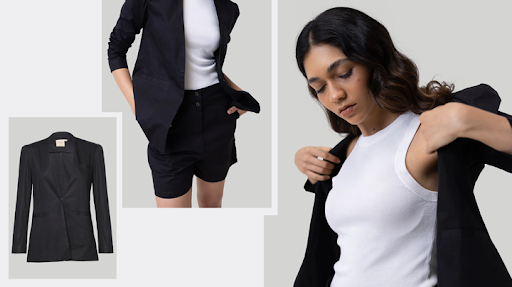Eco-Friendly Clothing: How to Make Smarter Choices for the Planet
By PAGE Editor
Fashion has always been a powerful means of self-expression. It allows individuals to share their personal stories with the world. But this narrative has taken a one-way route, disregarding the planet and the people who make our clothes.
With climate change intensifying and resources running thin, the urgency for change is even greater. This urgency is eye-opening and makes the world realize that fashion shouldn't come at the expense of our planet.
Sustainable fashion may seem unfamiliar to some of us, and with so much conflicting information available, it can be overwhelming to understand the differences and to make a conscious choice.
However, embracing sustainable clothing need not be complicated. So, let’s unclutter how eco-friendly clothing can be as simple as finding options that reflect quality and responsibility.
Unmasking Fashion’s Sustainability Illusion
Since the early 2000s, dwindling natural resources and climate changes have pushed businesses to embrace global sustainability, a balance of profit, people, and the planet, known as the Triple Bottom Line (TBL).
Fashion has long been guilty of greenwashing, adapting to trends where the terms “natural” and “recycled” masked ethical lapses in the industry. But sustainability often gets boxed into a single category: environmental. Workers' rights, fair wages, and child labor often remain in the shadows, while recycling and repair take over the spotlight.
The result?
Consumers are left confused about what sustainability truly means and why it matters. It's time to rethink and demand transparency in the business of sustainability.
How to craft an eco-friendly wardrobe?
The question isn’t whether you can make sustainable choices but how to do it without sacrificing your flair.
It All Starts with Materials That Care
At the heart of sustainable fashion lies the threads that you choose. Some fabrics are guilty of using more resources, while fabrics like hemp, tencel, bemberg, and others used by eco-friendly brands like Reistor, tread lightly on the Earth.
Here’s a glimpse into the choice of materials Reistor focuses on:
Hemp: Renewable, biodegradable, and low-impact, this eco-conscious fabric redefines sustainable fashion. Offering both durability and timeless appeal, it seamlessly merges style with environmental responsibility. It was in 2021 that Reistor introduced hemp in its debut collection, and has been a part of their sustainable clothing journey ever since.
Linen: Derived from the fast-growing flax plant, which takes about 100 days to grow, linen is valued for its breathable texture and effortless sophistication. Used in fashion for centuries, owing to its lightweight, linen is a biodegradable fabric, which is timeless and chic.
Tencel™: Denim, made entirely from Tencel™, can be another addition to your eco-friendly wardrobe. The fibers are derived from sustainable wood sources that recover and recycle solvents, making the fabric both comfortable and a responsible choice while also fitting into the arena of eco-friendly clothing.
Bemberg™: By removing all impurities from the yarn, Bemberg™ is transformed into a thread, which results in an incredibly soft, lightweight, breathable, and versatile material.
Organic Cotton: Organic Cotton replicates the lightness and breathability of regular cotton without harming the environment. Grown without the use of pesticides and chemical fertilizers, this material supports sustainability in its true sense by supporting the local environment and communities along with it.
Quality over Quantity
Fast fashion has convinced us that the more, the better. But is it so?!
What we wear carries an impact beyond trends, influencing a larger environmental story. However, when it comes to fashion, most of us are unaware of its side effects. Here’s how you can make sustainable choices,
Invest in Essential Pieces: Curate a selection of versatile essentials that mix and match seamlessly. Pair up your jeans with tops, which you can style with skirts as well. Wear your shirts in more than one way. Let it loose on some days, tuck it in, or tie a knot if you're in the mood.
The timeless collection: Timeless classics are always in style. Choose pieces that you can wear season after season. White shirts, blazers, and the perfect pair of jeans can never go out of style.
Imbibe the Rs
Sustainability doesn't stop at buying better; it extends to what you do with your clothes as well. Before tossing them out, repair, redesign, and re-wear your clothes.
Repair: Whether it’s stitching a tear or sewing on a button, these skills are worth their weight in gold.
Re-wear: A sustainable wardrobe begins with making the most of what you already own. Re-wearing and reinventing your wardrobe not only extends the life of each piece but also cultivates a more mindful approach to fashion.
Read between the Labels
Garment care labels provide more than just washing instructions. They also reveal fabric composition, helping you determine if a piece is made from eco-friendly materials.
Greenwashing Red Flags: Words like 'eco-friendly’ and 'sustainable’ can be marketing fluff. Remember, true sustainability doesn't need smoke and mirrors. Look for fabric origins, certifications, and brand initiatives.
Swapping is the New Shopping
Swapping isn't just a trend; it is a shift towards zero-waste fashion. So, why buy when you can swap?
Host A Swap Party: Invite friends, bring your unused pieces and trade treasures. It's fun, social, and sustainable. Not only will you refresh your wardrobe for free, but you'll also give new life to the forgotten pieces.
Community Swaps: Many local communities and online platforms host regular clothing swaps. It's like shopping minus the price tag. These communities are the treasure troves of eco-friendly clothing.
Laundry Day, the Eco Way
Your laundry habits can either preserve your clothes or fast-tract them to the donation pile. A few simple initiatives can save energy and water and contribute to eco-friendly clothing.
Cold is the New Hot: Washing clothes in cold water reduces energy use and keeps fabrics looking fresh. Heat can weaken fibers, which leads to wear and tear. On the other hand, cold water can get the job done while keeping your outfits looking fresh.
Ditch the Dryer: Air-drying is your garment's best friend. It reduces energy consumption and keeps fabrics intact for a longer period.
When It’s Time to Let Go
Every piece of clothing has a story, but when it is time for the final chapter, make sure that it doesn’t end in a landfill.
Donate with Purpose: Instead of discarding clothes, pass on gently used clothes to shelters or thrift stores where they’ll find a second life. Your old favorites could become someone else’s new treasures.
Recycle Responsibly: Many brands now offer take-back programs to recycle old clothing into new fabrics. Drop off your used pieces at these programs, and you’ll help close the loop on textile waste.
Where Style Meets Sustainability
Sustainability is about stepping away from fleeting trends and curating a wardrobe that doesn't just make you look good but feel good as well.
The story your wardrobe carries is more than fabric and stitches. It’s a narrative of choices, values, and the world you want to shape. Every hem, every button, every thread has a voice, whispering tales of the planet, the hands that created it, and the future you’re building with every purchase.
So, with sustainable fashion brands in the market like Reistor, you will find pieces that carry a legacy, not just a price tag. True style isn't about chasing what is momentary; it is about curating what lasts, what matters, and what aligns with you.
And when fashion becomes an act of art, purpose, and care, it is no longer just something you wear; it is a reflection of who you truly are.
HOW DO YOU FEEL ABOUT FASHION?
COMMENT OR TAKE OUR PAGE READER SURVEY
Featured









The Fear of God Essentials tracksuit has taken the style international through storm, mixing consolation and fashion in a manner that resonates with a numerous audience.